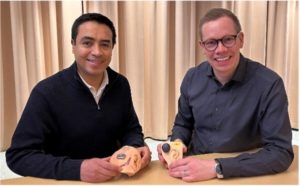Global Product Managers, Ivan Gonzales (left) and Daniel Rhodin (right), work at Cochlear’s Bone Conduction Headquarters in Gothenburg, Sweden, a renowned hub for innovation in medical technology and life sciences.
State-of-the-art vision
Daniel explains the vision behind the Osia System and the benefits of its state-of-the-art piezoelectric technology.
“The Osia System was developed to remove certain barriers to bone condution treatment – to tackle the limitations of traditional hearing aids and other bone conduction devices. Our aim was to create a solution that offers superior sound quality, comfort and reliability, that does not limit a recipient to live their life as fully as possible.
“The unique piezoelectric transducer inside the implant offers several advantages over the traditional technology used by all other bone conduction systems. For one thing, it’s more sensitive in the higher frequencies. This means it can deliver more output using the same amount of energy. With more power to assist with improved speech understanding in noise and quiet, the Osia System is the only active system indicated for up to a 55 dB sensorineural hearing loss (SNHL).”
Important MRI compatibility
Unlike other bone conduction systems, the piezoelectric transducer is not powered by magnets. This means recipients with the Osia OSI300 implant can undergo high-resolution MRI scans, which is significant because many people will need to undergo an MRI at some point in their lives.
Because there is no magnet in the Osia System’s piezo transducer, the Osia Implant is not affected by the strong magnetic fields in an MRI.
Ivan expands on this. “The Osia System, with the Osia OSI300 implant is the only active system that ensures recipients have the same access to 1.5T and 3.0T MRI as those without implants.1
“Additionally, there is no risk of decreased implant performance after MRI examinations, unlike other active implants that use electromagnetic transducers.2-6 Patients with an OSI300 Implant only need to remove their sound processor before undergoing 1.5T or 3.0T MRI – no surgical procedure is required.”2
Positive feedback
Daniel tells us that feedback from Osia recipients is good. “They usually say that the sound is clearer and that they no longer worry about feedback. They put on the Osia in the morning and basically can forget that they are wearing it until they remove it at night.”
As we celebrate its 5-year anniversary, there are now more than 25,000 people worldwide, who hear even better than ever with Osia.
Watch this video to meet Ryan, who began his Cochlear journey with Baha® Softband but now enjoys a more independent life with the Osia System.
Five years is only the start
Ivan is honoured that professionals and patients alike have embraced the Osia System during the five years since it first became available.
“Its accelerated adoption by patients and professionals is evidence of how this significant and one-of-a-kind leap forward in bone conduction technology has resulted in incredible progress for our patients. We are so thankful.”
Cochlear could not have reached this milestone without the trust of every individual who has been identified as a candidate for the Osia System.
Ivan adds, “this is only the start with Osia, and we will continue to invest in research and development … to keep pushing the boundaries of what is possible in hearing health.”
All of us at Cochlear look forward to being part of your Osia journey in the next 5 years and beyond!
You can learn more about the Osia System here
- D1884441-V6 Cochlear Osia Magnetic Resonance Imaging (MRI) Guidelines EN-GB
- Technical Brief – Reliability: Cochlear™ Osia® OSI300 Implant. D1991745. October, Cochlear Limited 2023.
- OSI300 1.5 T MRI Verification Summary Report. Cochlear Limited, Australia. 2023; D2084831
- OSI300 3.0 T MRI Verification Summary Report. Cochlear Limited, Australia. 2023; D2084832
- https://www.medel.com/important-safety-information
- MRI Checklist for MED-EL Bone Conduction Implant BCI 601. AW52570_1.0. MED-EL Elektromedizinische Geräte GmbH, Austria
The OSI300 Implant is MR conditional at 1.5T and 3 .0T with magnet in place. The OSI200 Implant is MR conditional at 1.5T with the implant magnet in place and the use of the Cochlear MRI Kit or with the magnet surgically removed. Patients can be scanned at 3.0T with OSI200 Implant magnet removed. Refer to Osia MRI guidelines for further information.
